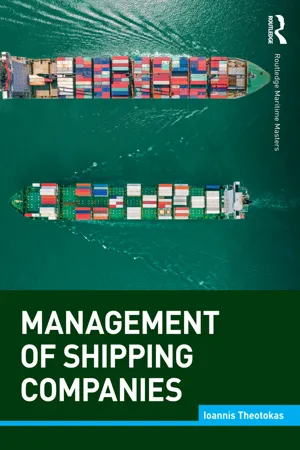
- 310 pages
- English
- ePUB (mobile friendly)
- Available on iOS & Android
Management of Shipping Companies
About this book
The maritime sector is dynamic and volatile, creating the need for continuous monitoring of the latest developments and their effects on the organisation, management and strategies of shipping companies. This book analyses the business environment of these companies and the approaches they adopt in organising and managing their activities.
Management of Shipping Companies aims to facilitate the learning and understanding of the fascinating world of shipping business. It examines the organisation and management of companies which manage ocean-going ships, emphasising the special characteristics of the industry and the framework created by these. This textbook offers a detailed account of the companies' processes and functions, the structural and contextual dimensions of their organisation, as well as an analysis of human resources, safety management and the outsourcing of shipping operations. Written in an easily digestible and critical manner, it includes case studies and analysis of best practices implemented by companies worldwide.
This unique and accessible book is an ideal text for students in maritime studies programs as well as readers interested in learning about maritime businesses' organisation and management.
Frequently asked questions
- Essential is ideal for learners and professionals who enjoy exploring a wide range of subjects. Access the Essential Library with 800,000+ trusted titles and best-sellers across business, personal growth, and the humanities. Includes unlimited reading time and Standard Read Aloud voice.
- Complete: Perfect for advanced learners and researchers needing full, unrestricted access. Unlock 1.4M+ books across hundreds of subjects, including academic and specialized titles. The Complete Plan also includes advanced features like Premium Read Aloud and Research Assistant.
Please note we cannot support devices running on iOS 13 and Android 7 or earlier. Learn more about using the app.
Information
CHAPTER ONE
The shipping company
CONTENTS
Shipping in the nature of things is no easy matter. You have 20–25 people on a ship with their own problems. Your vessels constantly operate with dangerous cargoes in difficult weather conditions, you have to negotiate with charterers from all over the world … Briefly put, shipping is one of the most complicated of jobs.(Tsakos, N., 2010:32)
There are not many industries where can one pick up the phone and in five minutes hire a vessel for USD 5 million, with a USD 100 million cargo on a USD 130 million asset, and with USD 1 billion of insurance, without lawyers and lengthy contract negotiations.(Sohmen-Pao, 2005:15)
Introduction
Basic distinctions in the shipping industry
A. Bulk shipping
B. Liner shipping
Table of contents
- Cover
- Half Title
- Title Page
- Copyright Page
- Dedication
- Table of Contents
- About the author
- Introduction
- 1 The Shipping Company
- 2 The External Environment of Shipping Companies
- 3 The Processes of the Shipping Company
- 4 The Organisation of the Shipping Company
- 5 Contextual Factors of Organisational Structure
- 6 Departmentalisation in Shipping Companies
- 7 Human Resource Management in Shipping Companies
- 8 Management of Human Resources of Ships
- 9 Safety Management in Shipping Companies
- 10 Outsourcing of Ship Management
- Index